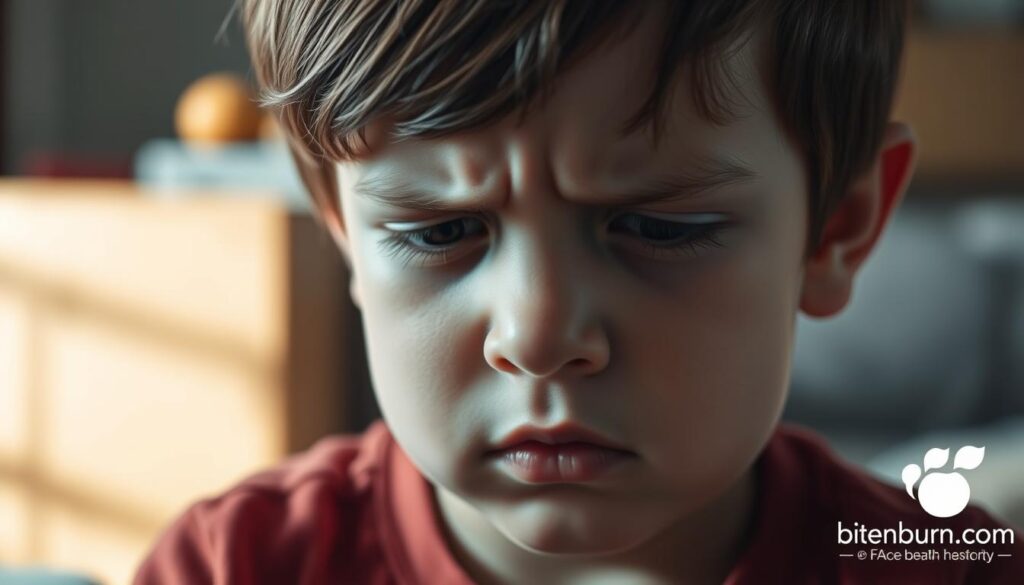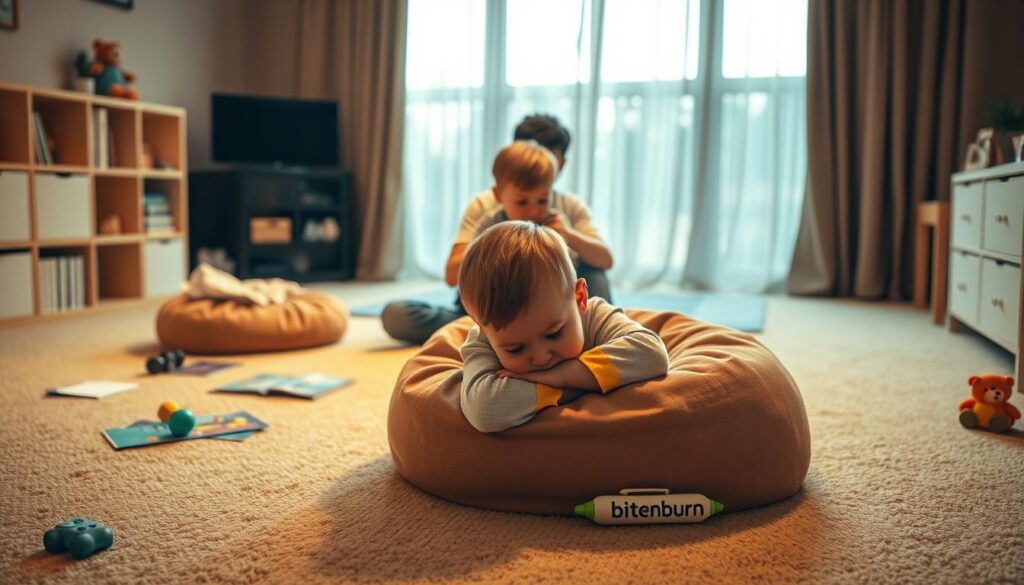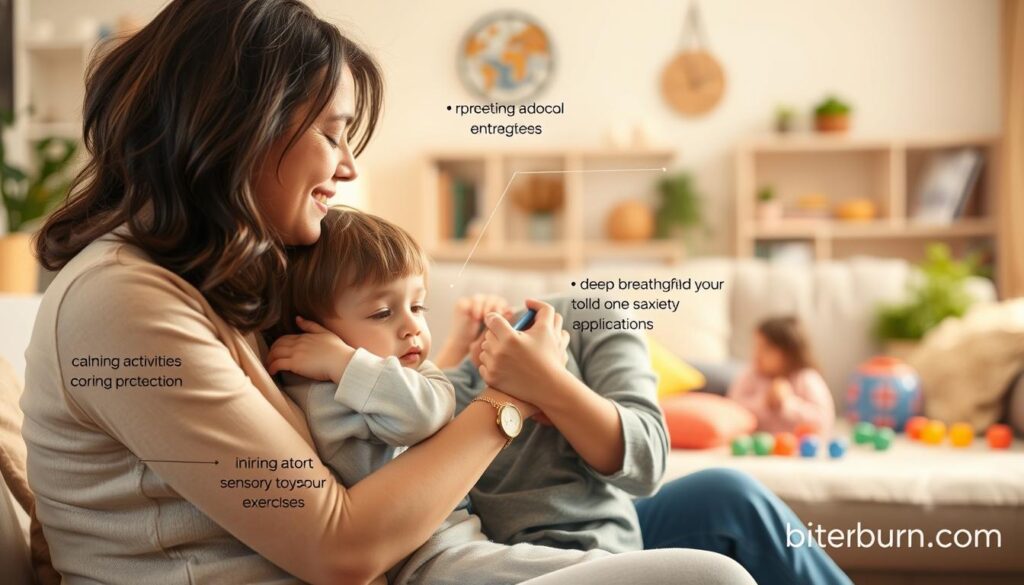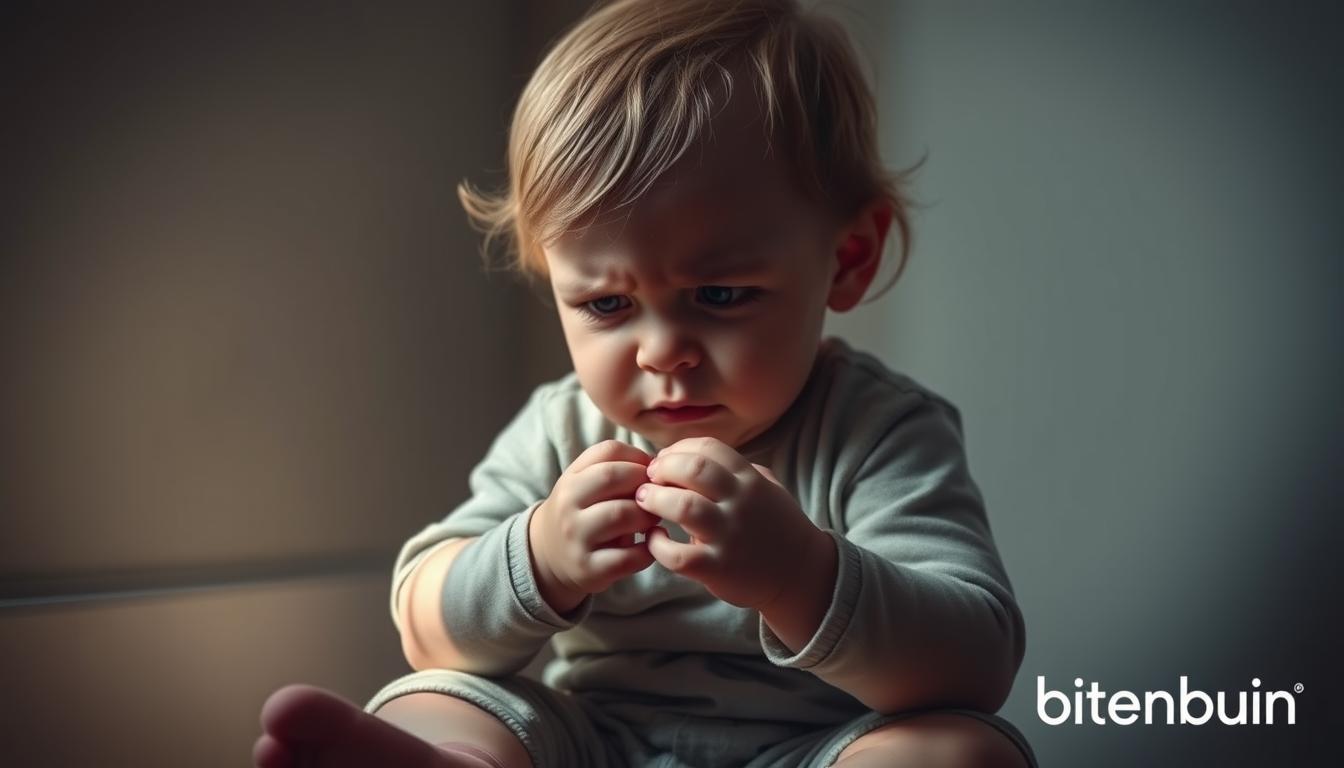Did you know 1 in 14 children under age 6 shows signs of anxiety that disrupt daily life? While many assume emotional struggles only affect older kids, research reveals nearly 10% of 2- to 5-year-olds experience symptoms needing attention. These early challenges often go unnoticed because young children express worries through actions rather than words.
Spotting anxiety in early childhood requires careful observation. Behaviors like excessive clinginess, sleep disruptions, or sudden tantrums might signal deeper struggles. The CDC reports 7.1% of U.S. children have diagnosed anxiety disorders, but many cases remain undetected during critical developmental years.
We created this guide to help families identify patterns that differ from typical childhood fears. While brief worries about monsters or separation are normal, persistent distress lasting over six months often warrants support. Early recognition empowers caregivers to respond effectively and connect children with tools for emotional resilience.
Key Takeaways
- Anxiety affects 1 in 10 children aged 2–5, though many cases go undiagnosed
- Physical behaviors often reveal anxiety more clearly than verbal cues in toddlers
- Six months of consistent symptoms may indicate a clinical concern
- Early intervention improves long-term mental health outcomes
- Professional guidance helps distinguish typical fears from disordered anxiety
Understanding Anxiety in Toddlers
Many caregivers mistake intense childhood worries for temporary phases. True anxiety in young children involves persistent feelings that reshape daily routines. Unlike brief fears of thunderstorms or new faces, clinical concerns linger for months and limit a child’s ability to explore their world.
What Is Anxiety in Toddlers?
We define this condition as overwhelming distress affecting a child’s play, learning, or relationships. While separation jitters at daycare are normal, an anxiety disorder emerges when distress persists beyond developmental expectations. Physical signs like stomachaches often replace verbal expressions of worry.
Common symptoms include refusal to join group activities or extreme resistance to minor changes. These reactions differ from age-appropriate caution because they create lasting barriers to healthy development. The American Psychological Association notes that early childhood anxiety frequently manifests through behavioral changes rather than direct statements.
Why Early Recognition Matters
Identifying patterns before age five significantly improves long-term mental health outcomes. Untreated cases may lead to academic struggles or social withdrawal by elementary school. Research shows early intervention reduces future anxiety disorder risks by 50% in some studies.
Timely support helps children build coping skills during critical brain growth periods. Families who address concerns early often prevent secondary issues like sleep disturbances or feeding challenges. Our guide on key signs offers practical strategies for observing these subtle shifts.
How to Recognize Anxiety in Toddlers

Caregivers often notice shifts in behavior before understanding their meaning. We recommend tracking three key areas: physical reactions, emotional responses, and routine disruptions. Lasting changes across multiple weeks often reveal more than single incidents.
Behavioral Clues That Demand Attention
Children express unease through actions rather than words. Look for repeated resistance to ordinary situations like car rides or bath time. Some young ones develop rigid routines, becoming upset if mealtimes or play sequences change.
| Behavior | Typical Expression | Concerning Pattern |
|---|---|---|
| Separation | Brief tears at daycare drop-off | 30-minute meltdowns recurring for weeks |
| Social Interactions | Shyness with new people | Refusing to join familiar playgroups |
| Eating Habits | Pickiness with certain foods | Consistently skipping meals |
Physical symptoms like recurring stomachaches often accompany emotional distress. The American Academy of Pediatrics notes that 35% of children with unexplained aches show anxiety markers. Track frequency with a simple calendar system:
- Note time and context of each complaint
- Record associated activities or changes
- Compare weekly patterns
Regression in mastered skills signals particular concern. A potty-trained preschooler having frequent accidents or a verbal child resorting to baby talk may need support. Document these changes using video clips or dated notes for pediatric consultations.
Key Signs and Symptoms in Toddlers
Young children often communicate distress through their bodies before their words. We observe patterns across three areas: physical reactions, emotional shifts, and behavioral changes lasting weeks. These clusters help distinguish temporary upsets from deeper concerns.
Physical Signs of Anxiety
Bodily symptoms frequently surface without fever or illness. Tense shoulders, nail-biting, or shaky hands during stressful moments may signal unease. Sleep struggles often escalate – 65% of children with nighttime resistance show daytime anxiety markers.
| Symptom | Typical Occurrence | Concerning Pattern |
|---|---|---|
| Stomachaches | Before big events | Daily complaints without cause |
| Restlessness | After sugary snacks | Constant fidgeting |
| Sleep Issues | During travel | Nightly bedtime refusal |
Emotional and Behavioral Indicators
A child may cling to routines like strict mealtime rituals. Separation anxiety often peaks when facing daycare drop-offs or new caregivers. Watch for:
- Repeated “checking in” during play
- Meltdowns over minor changes
- Avoiding favorite activities
These signs often intensify before school transitions or social events. One mother shared: “My son stopped joining soccer games he once loved – that’s when we knew.” Tracking frequency helps identify needs for support.
Impact on Child’s Development and Mental Health

Early childhood forms the foundation for lifelong learning and emotional growth. When anxiety goes unaddressed, it can reshape a child’s trajectory in surprising ways. Research shows persistent worries during these formative years often create ripple effects across multiple areas of development.
Benefits of Early Intervention
A child may experience delays in language skills if anxiety limits social interactions. Simple activities like playground visits or storytime become missed opportunities for growth. Studies reveal that 40% of children with untreated anxiety struggle academically by third grade compared to peers.
Family dynamics frequently shift when young ones face emotional challenges. Parents might unintentionally reinforce fears by avoiding triggers, creating cycles that deepen distress. One pediatric psychologist notes: “Supportive strategies work best when started before patterns become ingrained.”
Effective early approaches yield measurable improvements:
- 75% reduction in school avoidance behaviors
- 50% higher emotional regulation scores
- 60% fewer sleep disturbances
Children receiving timely support often develop stronger problem-solving skills. These abilities help them navigate life events like new siblings or classroom transitions. Early intervention doesn’t erase challenges – it builds resilience for facing them.
Long-term mental health outcomes improve dramatically with proper attention. Data from Johns Hopkins shows adolescents who received help as toddlers have 30% lower depression rates. Addressing concerns early creates pathways for healthier relationships and academic success.
Types of Anxiety in Young Children

Young minds experience worry through different lenses, with specific patterns shaping their responses. While temporary fears are normal, certain anxiety disorders require careful understanding. Three primary forms dominate early childhood: separation concerns, social fears, and broader clinical conditions.
Separation Anxiety vs. Social Anxiety
Separation anxiety surfaces through intense reactions to caregiver absences. Children might sob uncontrollably during daycare drop-offs or refuse sleepovers. Physical symptoms like headaches often appear when anticipating time apart from family members.
| Type | Key Triggers | Common Reactions |
|---|---|---|
| Separation | Parent leaving room | Clutching caregiver’s clothes |
| Social | Peer interactions | Hiding behind furniture |
Social anxiety involves discomfort around people beyond immediate family. A child might freeze during birthday parties or whisper only to parents in public. Selective mutism – complete silence in specific situations – often signals deeper social worries.
Understanding Anxiety Disorders
Generalized anxiety disorder manifests as constant unease about multiple life aspects. A preschooler might fret about weather changes, meal times, and playground safety simultaneously. Phobias create intense fears of particular objects like elevators or animals.
- Post-traumatic stress: Nightmares after traumatic events
- OCD: Repetitive hand-washing rituals
- Co-occurring conditions: 40% with autism show anxiety markers
Professional evaluation becomes crucial when behaviors persist beyond six months. As one child psychologist notes: “Early diagnosis helps tailor support strategies before patterns solidify.” Families should consult specialists when playdates or daily routines feel consistently disrupted.
Practical Strategies and Support Resources

Families facing childhood worries need actionable tools. Simple adjustments at home combined with professional support create powerful results. We focus on methods that build confidence while addressing core concerns.
Daily Techniques for Emotional Growth
Consistent routines help children feel secure. Try these evidence-based approaches:
| Strategy | Implementation | Benefit |
|---|---|---|
| Routine Building | Fixed meal/bedtimes | Reduces uncertainty triggers |
| Gradual Exposure | 5-minute playdate increments | Builds social tolerance |
| Relaxation Practices | Bubble breathing exercises | Teaches self-regulation |
Validate feelings without reinforcing fears. Say: “I see this feels scary. Let’s try together.” Avoid over-accommodating requests to skip activities.
Partnering With Professionals
Contact child psychologists if challenges persist. Prepare for appointments by:
- Tracking symptoms for 2 weeks
- Filming concerning behaviors
- Listing family mental health history
Organizations like NAMI offer free parent workshops. Many schools provide counselors trained in child anxiety management. As one specialist notes: “Early collaboration prevents escalation.”
Expert Advice, Treatment Options, and Parental Support
Modern approaches to childhood emotional challenges combine professional guidance with practical home strategies. When symptoms anxiety persist beyond six months, specialists often recommend structured interventions. These methods address both immediate needs and long-term mental health goals.
Medical and Therapeutic Interventions
Cognitive Behavioral Therapy (CBT) helps children reframe overwhelming thoughts. Therapists use play-based techniques to teach coping skills tailored to different types anxiety. Studies show 68% of young patients improve significantly within 12-16 sessions.
For severe cases, doctors may prescribe SSRIs alongside therapy. These medications typically take 2-4 weeks to show effects. Always consult pediatric specialists before considering pharmaceutical options.
Key treatment components include:
- Weekly therapist-led sessions building emotional vocabulary
- Parent coaching for consistent home support
- Gradual exposure exercises reducing avoidance behaviors
Early intervention prevents anxiety disorders from limiting a child’s social or academic growth. Regular progress checks ensure strategies evolve with developmental needs. Collaborative care creates lasting tools for managing life’s uncertainties.


[…] daily life. Changes in rest patterns can amplify stress levels, test patience, and create cycles of frustration. We’ll unpack why these moments matter far beyond […]
[…] daily patterns reduce stress hormones in young […]
[…] older children, 2-year-olds lack the vocabulary to say “I’m anxious” – instead, they show stress through actions we must […]